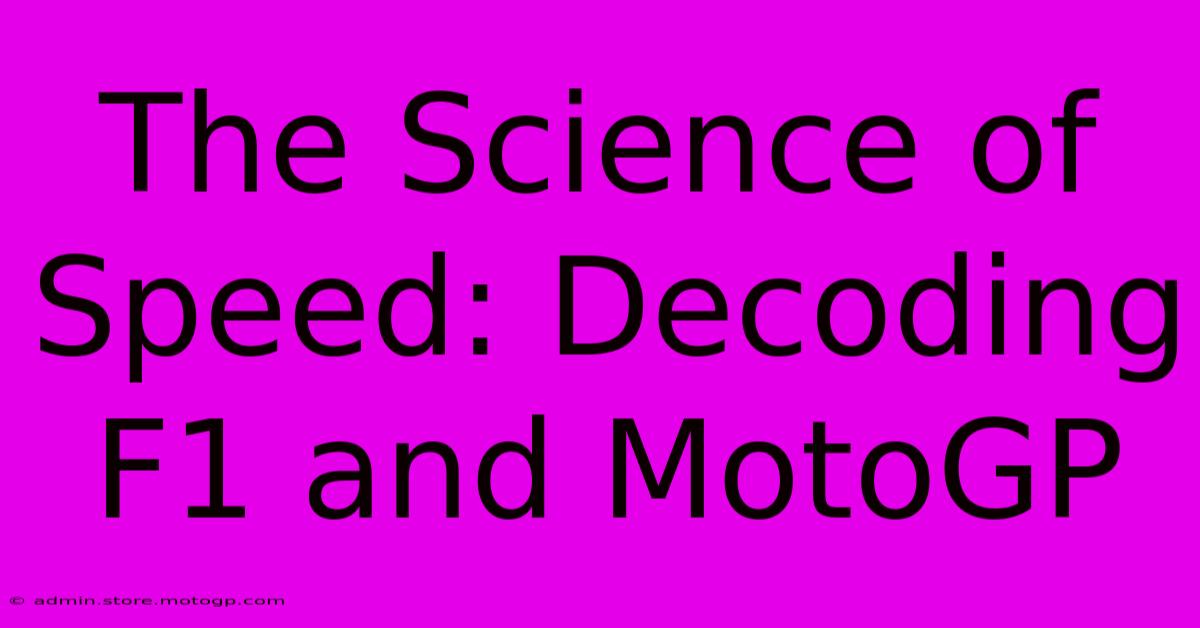The Science Of Speed: Decoding F1 And MotoGP

Table of Contents
The Science of Speed: Decoding F1 and MotoGP
The roar of the engines, the blur of speed, the nail-biting finishes – Formula 1 and MotoGP represent the pinnacle of motorsport, pushing the boundaries of engineering and human performance. But beyond the spectacle lies a fascinating world of scientific innovation, where aerodynamics, materials science, and human physiology intertwine to create breathtaking speed. This article delves into the scientific principles that underpin these thrilling disciplines.
Aerodynamics: The Unsung Hero of Speed
In both F1 and MotoGP, aerodynamics play a crucial role. These vehicles are designed to minimize drag and maximize downforce.
F1's Winged Wonders:
Formula 1 cars are masterpieces of aerodynamic design. The complex interplay of wings, diffusers, and bodywork generates significant downforce, pressing the car to the track at high speeds, enabling incredible cornering capabilities. The shape and angle of these components are meticulously tuned in wind tunnels and computational fluid dynamics (CFD) simulations to optimize performance at various speeds and track conditions. Even minute adjustments can significantly impact lap times. The constant evolution of aerodynamic regulations adds another layer of complexity, pushing engineers to find ever-more ingenious solutions.
MotoGP's Sleek Streamliners:
MotoGP bikes, while seemingly simpler than F1 cars, also rely heavily on aerodynamics. Fairings are sculpted to minimize drag, while wings and winglets generate downforce, keeping the front wheel grounded and enhancing stability at high speeds. The rider's position also plays a critical role, influencing airflow around the bike and impacting overall performance. The interplay between rider and machine is key in optimizing aerodynamic efficiency.
The Powertrain: Harnessing Horsepower
The engines powering these machines are marvels of engineering, representing the cutting edge of internal combustion technology.
F1's Hybrid Powerhouses:
Formula 1 cars utilize highly sophisticated hybrid power units, combining internal combustion engines (ICE) with energy recovery systems (ERS). The ERS captures energy during braking and converts it into additional power, providing a significant boost during acceleration and overtaking maneuvers. This intricate system demands precise control and efficient energy management for optimal performance.
MotoGP's Screaming Engines:
MotoGP bikes boast powerful, high-revving engines that deliver exceptional horsepower. These engines, typically inline four-cylinder units, are meticulously engineered for maximum power output within the stringent regulations. The development of these engines involves continuous innovation in materials science, combustion efficiency, and engine mapping to extract the maximum potential from each drop of fuel.
The Human Element: Pushing the Limits
The drivers and riders are not merely passengers; they are integral components of the system, pushing their physical and mental capabilities to the absolute limit.
G-Force and Endurance:
Both F1 drivers and MotoGP riders experience extreme G-forces during acceleration, braking, and cornering. This demands exceptional physical fitness, stamina, and resistance to fatigue. Specialized training regimes, including strength and conditioning, cardiovascular workouts, and even simulator sessions, are crucial in preparing them for the intense demands of racing.
Reaction Time and Precision:
The ability to react instantaneously, make split-second decisions, and execute precise maneuvers under immense pressure are critical for success. Years of training and experience hone these skills, allowing drivers and riders to push their machines to their limits while maintaining control. Mental fortitude plays an equally important role, allowing them to maintain focus and composure in high-pressure situations.
The Future of Speed: Continuous Innovation
The pursuit of speed in F1 and MotoGP is a never-ending quest. Continuous research and development in aerodynamics, materials science, engine technology, and even rider/driver physiology will undoubtedly lead to even more astonishing feats of speed and engineering in the years to come. The scientific principles at play will continue to evolve, pushing the boundaries of what's possible and captivating audiences worldwide.
Keywords: F1, MotoGP, speed, aerodynamics, downforce, drag, hybrid power unit, engine technology, materials science, rider fitness, driver fitness, G-force, reaction time, motorsport, science of speed, engineering, innovation.

Thank you for visiting our website wich cover about The Science Of Speed: Decoding F1 And MotoGP. We hope the information provided has been useful to you. Feel free to contact us if you have any questions or need further assistance. See you next time and dont miss to bookmark.
Featured Posts
-
Race Bikes For Sale Engineered For Victory
Feb 19, 2025
-
The Secret To Moto Gp Pole Position Qualifying Explained
Feb 19, 2025
-
Moto Gp Images To Inspire Your Inner Racer
Feb 19, 2025
-
Austin F1 Qualifying Key Moments
Feb 19, 2025
-
Austin Gp Concert The Hottest Tickets In Motorsports
Feb 19, 2025
